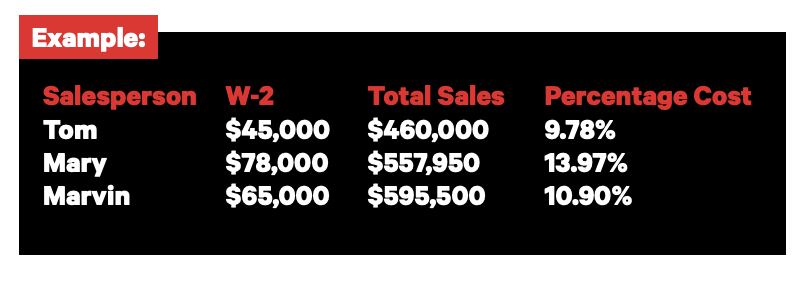HERE’S HOW TO figure each salesperson’s productivity: On a piece of paper, make four columns with these headings: salesperson, W-2, total sales, and percentage cost.
You’ll then list each of your salespeople in the salesperson column. Total sales should include product sales, special orders, repairs, custom design, watch repair and batteries. Now divide their W-2 by their sales. This will show you what percentage of each dollar they bring in they get for their pay.
This exercise shows you that the lowest paid person, Tom, is the most efficient. His paycheck is only 9.78% of his sales. Meanwhile Mary, who is paid $33,000 more than Tom, maybe because she’s been there longer, is not as good on the sales floor as Tom (relative to earnings). Marvin is almost close to being as efficient as Tom, costing as a percentage much less than Mary.
The Friedman Group helped with my compensation plan years ago, and I was told sales staff should cost a store anywhere between 8 to 15% of their sales (8% is very efficient while 15% is inefficient).
When I did this exercise, I found that my highest-paid salesperson, who had been a sales manager at a major chain, brought in the lowest total sales and cost me 18%. Meanwhile, a young saleswoman who had no jewelry experience (and thus was the lowest paid) had the highest sales numbers and cost 8%.

We started paying the same commission system for everyone, and the numbers reversed. The salesperson who had the lowest sales had a drop in income while the highest salesperson’s pay increased greatly, as it should have.
Your sales commissions should give the staff something to look forward to and get paid well. If you’re paying a measly 1 to 3% commission, do you know what it costs to get lunch? Many stores commission checks hardly pay for lunch, much less a car note.
A good compensation plan should include a salary, but 50% or more of their pay should come from commissions/bonus and spiffs, which allow salespeople to earn more money based upon their hard work. If you pay people straight hourly or salary — no matter how hard or little they work — they receive the same amount of money.
Want to see if I’m right? Every store has old inventory. Put these items in a separate case, and if your commission is a number like 4%, double it to sell those old items and see what happens.
Don’t pay commission at all? Again, have an “old dogs” case and pay the staff 8% to sell anything out of that case. Have fun with it and put a sign on the case, allow the staff to discount, and no matter what it sells for, pay the 8%. Money to you is money, for crying out loud.